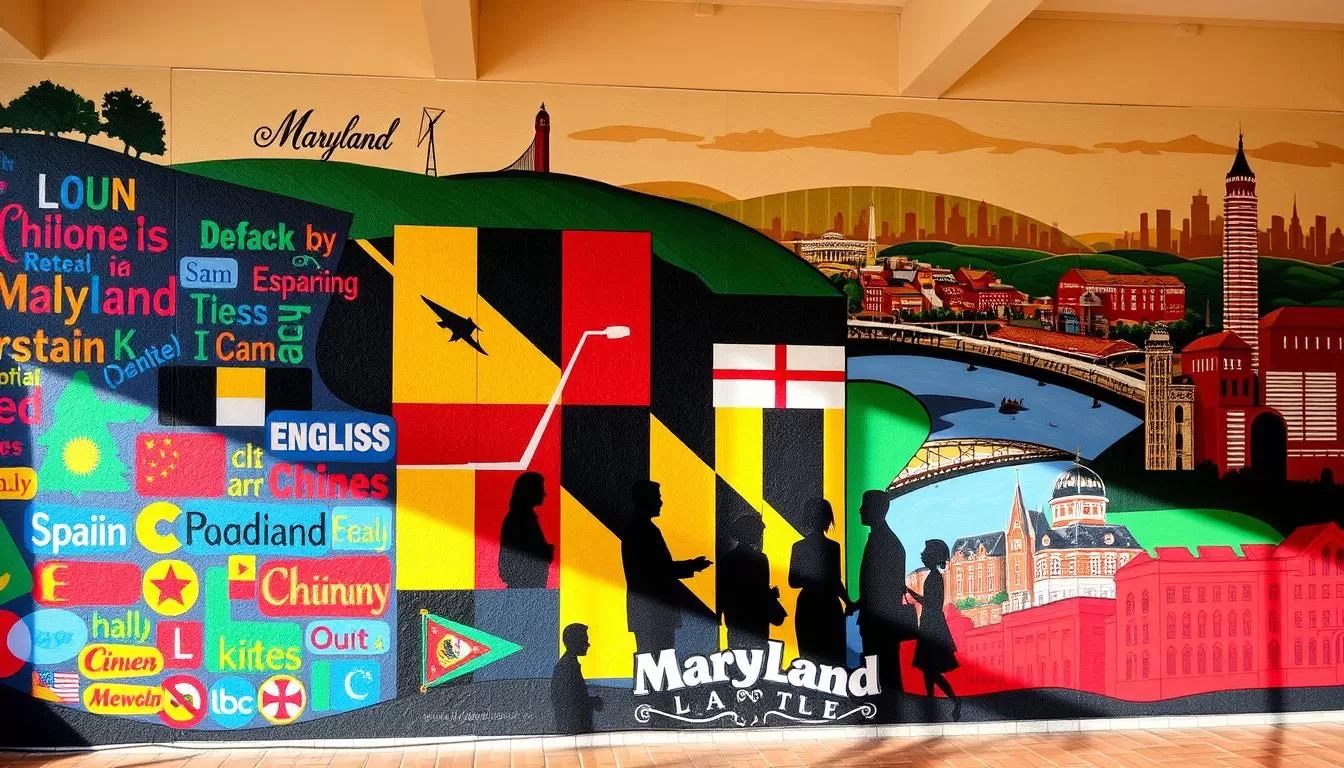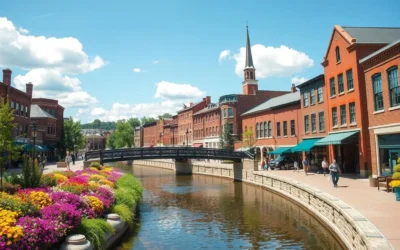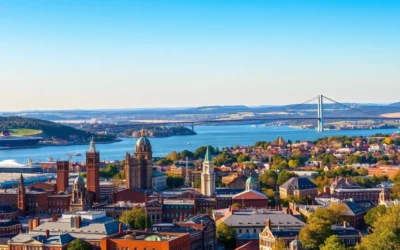✓ Accommodations✓ Flights✓ Rental Cars
As you explore the diverse state of Maryland, you’ll find a rich tapestry of languages spoken throughout its regions.
According to census data, a significant portion of the population in the Salisbury-Cambridge, MD-DE CSA speaks only English at home, with a percentage of 90.3%. This insight into the linguistic landscape provides a glimpse into the cultural diversity and demographic composition of Maryland.
You’ll discover that while English serves as the de facto language, there is no official language designated at the state level. This article will explore the languages spoken across Maryland and examine the language access services available to residents with limited English proficiency.
The Linguistic Landscape of Maryland
You will discover that Maryland’s linguistic diversity mirrors its demographic makeup. With a population that includes a majority of non-Whites, the fifth-highest percentage of African Americans, and significant numbers of residents born in Africa, Asia, Central America, and the Caribbean, the state’s language landscape is complex.
English as the De Facto Language
English is the predominant language in Maryland, with many residents speaking it as their first language. As the primary language for government, education, and daily life, English plays a crucial role in the state’s linguistic landscape. Most speakers in Maryland use English as their home language, making it the most widely spoken language in the state.
Language Diversity in the Old Line State
Maryland’s nickname, “America in Miniature,” reflects its linguistic diversity, with various non-english languages spoken across the region. The state’s immigrant population has created vibrant linguistic enclaves, particularly in urban centers like Baltimore and suburban Washington D.C. areas. Some key aspects of this diversity include:
- A variety of languages spoken by communities from around the world.
- The presence of significant speakers of languages from Latin America, Asia, and Africa.
- The reflection of Maryland’s demographic diversity in its linguistic landscape.

Maryland, United States: Official and widely spoken languages
As you explore Maryland, you’ll discover a tapestry of languages that reflect the state’s diverse population. The linguistic landscape is shaped by the state’s history, demographics, and the presence of various cultural communities.
Legal Status of Languages in Maryland
Maryland does not have an officially designated language at the state level, but English is the de facto language used in government and public services. You will find that English is predominantly used in official contexts, but other languages, particularly Spanish, are also widely spoken.
Language Demographics Overview
Census data provides insights into the language demographics of Maryland. According to the data, 90.3% of people in the Salisbury-Cambridge, MD-DE CSA speak only English at home.
- Approximately 10% of residents speak a language other than English at home.
- Spanish is the most widely spoken non-English language across the state.
- The number of speakers of Asian languages has grown substantially in recent decades.
The demographic breakdown is further illustrated in the following table:
| Language Spoken at Home | Percentage of Population |
|---|---|
| English Only | 90.3% |
| Spanish | 6.2% |
| Other Languages | 3.5% |
Understanding these language patterns helps public agencies and businesses better serve Maryland’s diverse populations. The data highlights the importance of language access services in the state.
Top 10 Non-English Languages in Maryland
In Maryland, you can hear a variety of languages being spoken, a testament to its diverse population.
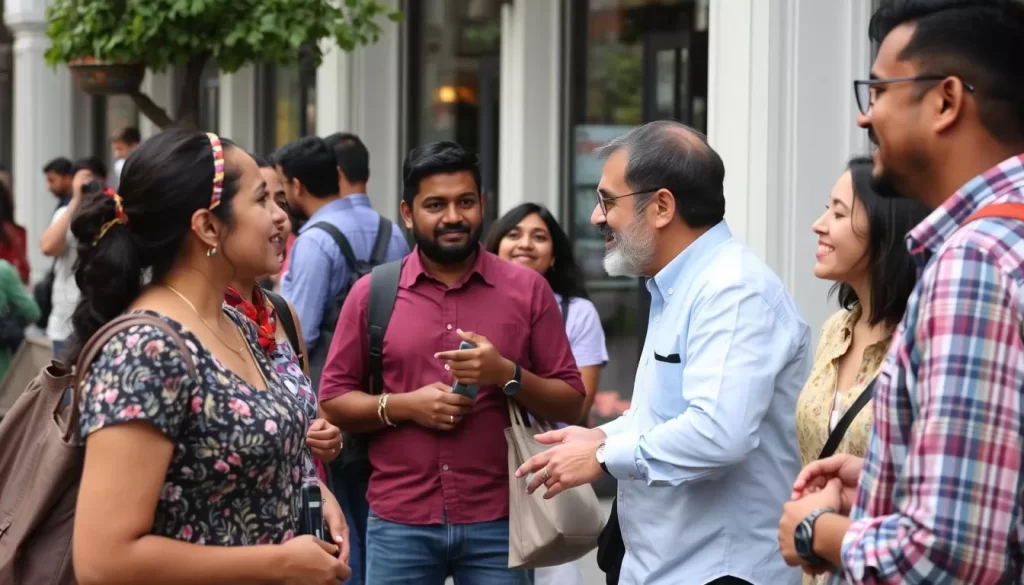
Spanish – The Most Prevalent Non-English Language
Spanish is the most widely spoken non-English language in Maryland. Many residents speak English as a second language, but Spanish is prevalent in daily life.
Chinese Languages
Chinese languages, including Mandarin and Cantonese, are also widely spoken. You can find Chinese cultural influences in certain neighborhoods.
Korean
Korean is another prominent language, with a significant number of speakers in the state. Korean communities contribute to the cultural diversity.
Vietnamese
Vietnamese is spoken by a considerable population in Maryland. The language is maintained through community programs and cultural events.
French and French Creole
French and French Creole languages are represented due to the influence of Haitian and other Francophone communities.
Tagalog
Tagalog, the language from the Philippines, is spoken by a significant number of residents, reflecting the state’s diverse immigrant background.
Russian
Russian has 8,713 speakers in Maryland according to census data. Russian speakers form a significant linguistic community, particularly in Baltimore County and Montgomery County.
- You’ll find Russian cultural influences in certain neighborhoods, with specialty stores, restaurants, and community organizations.
- Many Russian speakers in Maryland arrived during and after the dissolution of the Soviet Union.
- Russian language schools and cultural programs help maintain language skills across generations.
- Russian-speaking professionals contribute significantly to Maryland’s technology, healthcare, and academic sectors.
Regional Language Distribution Across Maryland
As you explore the linguistic landscape of Maryland, you’ll notice distinct regional patterns in language distribution. The state’s language diversity is shaped by its geography, with different areas exhibiting unique linguistic characteristics.
Baltimore Area Language Patterns
In the Baltimore area, you will find a diverse linguistic landscape. While English is widely spoken, other languages are also prevalent. The city’s demographic makeup contributes to its language diversity.
Some common languages spoken in the Baltimore area include Spanish, Chinese, and Korean. You may also like to know that language diversity in this region is influenced by the city’s cultural and economic ties.
Suburban Washington D.C. Language Diversity
Suburban Washington D.C., particularly Montgomery and Prince George’s counties, showcases exceptional language diversity. These areas are home to significant populations speaking languages such as Spanish, Chinese, Korean, Vietnamese, French/French Creole, and various African languages.
| County | Common Non-English Languages |
|---|---|
| Montgomery | Spanish, Chinese, Korean, French |
| Prince George’s | Spanish, Vietnamese, African Languages |
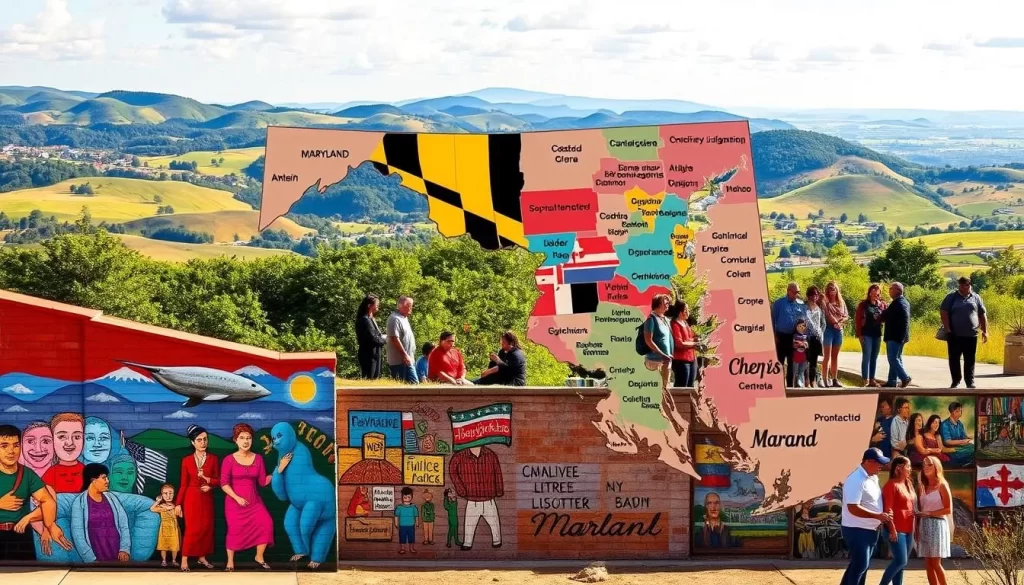
Historical Evolution of Languages in Maryland
As you explore the linguistic landscape of Maryland, you’ll discover a rich history shaped by multiple immigrant groups. The state’s language diversity is a result of successive waves of immigration that have reshaped the languages spoken in Maryland homes over time.

Colonial Language Heritage
Maryland’s colonial past has contributed significantly to its linguistic heritage. English became the de facto language, but other languages such as German and Native American languages were also spoken. The early linguistic diversity laid the foundation for the state’s future language landscape.
Impact of Immigration Waves on Language
The 19th century saw significant immigration from Europe, introducing languages such as German, Irish, Italian, and Eastern European languages. Later, the mid-20th century witnessed growth in Spanish-speaking populations, while the late 20th century brought increased Asian language diversity. More recently, African language communities, including Amharic, Yoruba, and Swahili, have grown substantially. Each wave has contributed to Maryland’s linguistic tapestry, with many eventually adapting to speaking English at home over time.
Language Access Services in Maryland
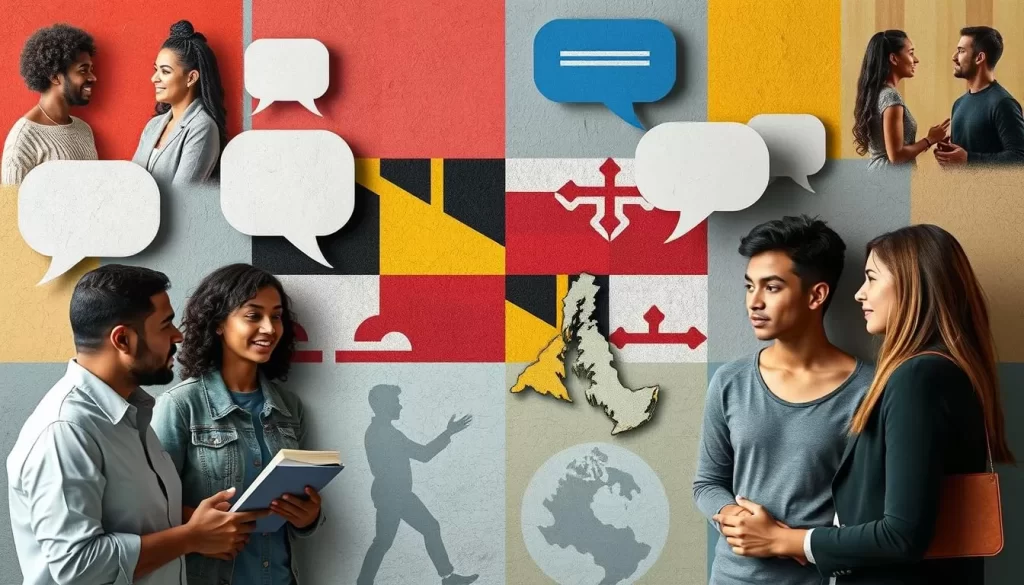
As you navigate the various services in Maryland, you may find that language access services play a crucial role in ensuring that everyone has equal access to information and services. Maryland’s language access services aim to provide equal access to information and services for all residents, regardless of their English proficiency.
Government Language Assistance Programs
Government agencies in Maryland offer language assistance programs to help residents with limited English proficiency. These programs may include interpreter services and translated materials to address your questions and concerns.
Educational and Healthcare Language Support
When it comes to education and healthcare, Maryland provides extensive support. You may also like to know that healthcare facilities must provide language assistance services under federal regulations. Major hospital systems in Maryland offer interpreter services, translated materials, and multilingual staff. ESOL (English for Speakers of Other Languages) programs operate in school districts throughout the state to help students develop English skills.
Limited English Proficiency in Maryland
As you navigate the diverse linguistic landscape of Maryland, you’ll encounter individuals who face challenges due to limited English proficiency. This issue affects many aspects of life, from healthcare access to legal matters.

Demographics of LEP Populations
Individuals with limited English proficiency come from various countries and form a significant part of Maryland’s diverse populations. They may struggle to speak English fluently, creating barriers in daily life.
Challenges and Support Systems
To address these challenges, Maryland has implemented various support systems, including interpreter services and translations of vital documents. These efforts aim to ensure equal access to services for all residents.
Comparing Maryland’s Language Diversity to Neighboring States
As you explore the linguistic landscape of the U.S., comparing Maryland’s language diversity to its neighboring states reveals interesting insights. Maryland’s linguistic diversity is shaped by its unique history, geography, and economic factors.
Similarities with Virginia and Delaware
Maryland shares similarities with Virginia and Delaware in terms of language diversity. These states have diverse populations with various languages spoken at home. You may also like to compare the linguistic diversity of these states further.
Differences from Pennsylvania and West Virginia
In contrast, Pennsylvania has significant Pennsylvania Dutch (German dialect) speaking populations not found in Maryland. Meanwhile, West Virginia has much lower linguistic diversity, with fewer immigrant communities. When comparing language diversity, it’s clear that each S. state has its unique characteristics, much like New York and New Jersey, which have higher percentages of residents speaking languages other than English.
Conclusion
As we conclude our exploration of the languages spoken in Maryland, it’s clear that the state’s linguistic landscape is a reflection of its diverse population. Language diversity is a key aspect of Maryland’s identity, shaped by the various cultures that call the state home.
The state’s approach to language diversity emphasizes inclusion and access, ensuring that all residents can participate fully in civic life regardless of their primary language. As demographics continue to shift, Maryland’s language landscape will continue to evolve, reflecting broader changes in American society and global migration patterns.
The above is subject to change.
Check back often to TRAVEL.COM for the latest travel tips and deals.
